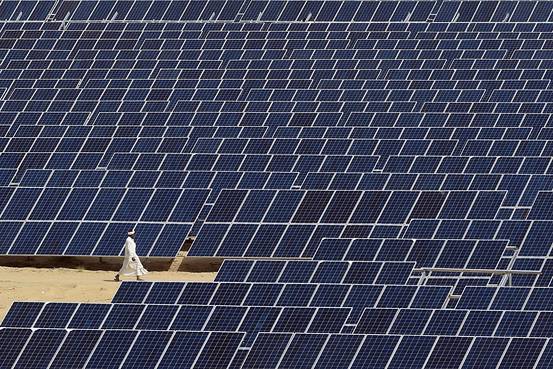
At the Paris climate talks, now in their second week, the spotlight is on India’s ambitious—very ambitious—commitments toward cleaner energy.
The most significant: New Delhi’s pledge to increase the amount of solar power that can be generated in the country to 100 gigawatts by 2022.
That’s more than 20 times India’s current solar deployment. It’s also more than all of Europe’s solar capacity, and more than half the world’s, as of the end of last year.
How can India pull it off?
In a new paper published by Stanford University’s Steyer-Taylor Center for Energy Policy and Finance, researchers Varun Sivaram, Gireesh Shrimali and Dan Reicher outline a roadmap.
The target, they acknowledge, is “perhaps at this point only aspirational.” Meeting it will require some potentially difficult reforms by both federal and state governments.
But the target won’t be achieved only by building the massive solar parks that are the Indian government’s focus today, the authors argue. Encouraging rooftop and off-grid solar projects will help create the broad political support crucial to the solar push.
For the biggest solar projects, which India hopes will account for 60 gigawatts of capacity by 2022, the cost of the electricity produced has already fallen beneath the cost of power generated from imported coal, and could soon be cheaper than power from domestic coal.
Still, solar developers face difficulties acquiring land and getting permissions to build transmission lines.
Deeper obstacles, the researchers write, lie with the utility companies that buy and distribute electricity to homes and factories.
Indian utilities’ ragged infrastructure and financial woes have deterred investment in both clean and unclean power generation. “Even if there is enough centrally generated power to meet on-grid consumer demand,” Messrs. Sivaram, Shrimali and Reicher write, “a significant amount of that power is lost as it travels through troubled electricity grids, and in many cases utilities are not even able to purchase all of the power generated by power plants.”
India’s utilities have racked up $55 billion in losses over the past six years. The federal government recently announced a plan for the country’s state governments to assume the debts of utilities that improve their operating efficiency.
As a backup, so to speak, Messrs. Sivaram, Shrimali and Reicher suggest creating a federally administered fund to buy power from solar generators when distribution companies aren’t in a position to do so, thereby reducing risks to developers.
Such a fund was outlined as part of a 2010 national solar program. It isn’t running yet.
The federal government could also help finance solar projects, the researchers write, by both subsidizing short-term loans and providing longer-term loans directly to developers.
That would be far more cost-effective for the government, according to the authors, than the tax benefits and capital grants currently offered to large solar projects. A currency-hedging facility could also be created to help attract foreign capital.
In rooftop solar installations, achieving India’s target of 40 gigawatts by 2022 would require a doubling of capacity each year. Using solar to supplement diesel generators could make a big difference to air pollution and energy costs for factories and office buildings in places where the grid is patchy.
The researchers note, however, that not all Indian states currently have mechanisms for customers to sell self-generated solar power back to the grid.
Enabling “net metering” would give a big push to personal solar installations, the researchers write, though they acknowledge that cash-strapped utilities may not be so keen to allow customers to zero out their power bills.
However, in a well-designed system, such as those that exist in parts of the U.S., utilities can use compensation for solar to keep commercial and industrial customers from exiting the grid altogether.
Currently, factories and offices in India pay vastly higher rates for electricity on the grid than those paid by homes and farms. State governments restrain utilities from raising prices for these customers.
Reducing subsidies would lift electricity prices and therefore the prices paid for rooftop solar power fed into the grid, making it more attractive for households, too, to invest in their own installations.
The smallest portion of India’s planned solar upgrade is in off-grid projects, which the government hopes will total 3 gigawatts by 2022.
Solar panels and batteries for powering appliances in a single home, as well as “microgrids” that serve a small cluster of power users, stand to bring enormous benefits to the 455 million in India who have limited or no access to the electricity grid, the authors write.
But few of these people can afford even the simplest solar technology, and finance options are limited, Messrs. Sivaram, Shrimali and Reicher write.
For solar vendors, collecting payments from village customers is difficult, and regulatory uncertainties can make developers reluctant to invest in rural places. If the grid is expanded unexpectedly into an area, then off-grid systems are put out of business.
The Indian government also subsidizes fuel for gas lamps, making solar even more uncompetitive.
Mr. Sivaram, a fellow at the Council on Foreign Relations, said reaching 100 gigawatts requires political commitment and smart interventions, not necessarily heaps of new government spending.
“Originally, last year, I thought it was a fake target—an overambitious target that was meant to catalyze progress,” Mr. Sivaram said from Paris, where the researchers are presenting their paper on Tuesday.
Instead, he has found that officials in Indian Prime Minister Narendra Modi’s government are “sincere in their belief that they can achieve this goal, and are willing to do what it takes.”
Mr. Sivaram said: “I get the sense, talking to the Modi administration, that this is a super-high priority, if not priority No. 1.”